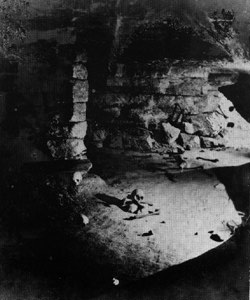|
Paris in the 13th Century transformed itself from feudal estates to
those the church and state, with the land and power divided equally.
Phillipe Augustus (1180-1223) begins public works such as the Cimtiere
des Saints Innocents and the masonry fortification around Paris to
relieve congestion. The wealthy dead were buried in cemeteries in and
around churches, so they would have better luck in the afterlife. The rest,
a wide social group, were relegated to mass graves. The largest was
the Cimetiere des Saints Innocents, which later was emptied into the Parisian
catacombs due to the stench of the rotting corpses. Strangely enough,
Saints Innocents was a popular spot for lovers, merchants and preachers.
Phillipe Auguste established the royal gallows of Montfaucon north
of Paris, serving not only as the gallows but also the town dump.
Thousands of people were hung there; those that died while being tortured
were left hanging to rot until their bones fell. Their remains would then
be dumped into a pit along with the household waste, excrements and
rubble. Like the Christian denial of burial to criminals, the smell that
emanated down to Paris served as a subtle deterrent to crime. This practice
also continued well into the 18th Century. Parent-Duchatelet, the early
19th century hygienist, refers to Montfaucon as the "Epicenter of Stench."
Although the execution of criminals no longer occured at Montfaucon
in the 18th century, bodies still were dumped there along with the
garbage, including the bodies of the people beheaded during the French Revolution. After the revolution, the christian denial of burial
to criminals ceased; however, the ties of Montfaucon with
unimaginable horrors remained.
 Felix Nadar photo of the catacombs 1861
Catacomb visits are at Place D'Enfer-Rocherau
Felix Nadar photo of the catacombs 1861
Catacomb visits are at Place D'Enfer-Rocherau
http://www.translucency.com
|